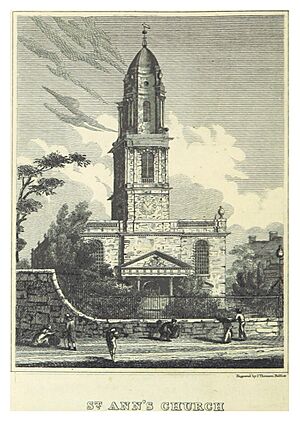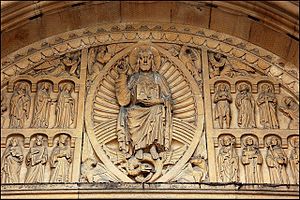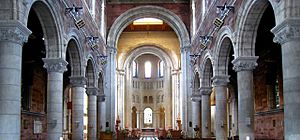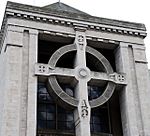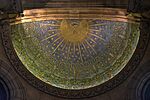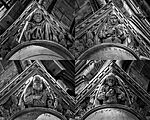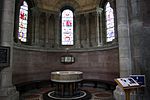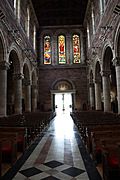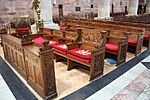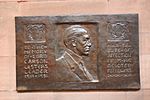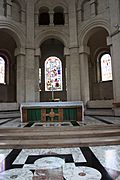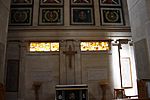St Anne's Cathedral, Belfast facts for kids
Quick facts for kids Belfast Cathedral |
|
|---|---|
| The Cathedral Church of St. Anne, Belfast | |
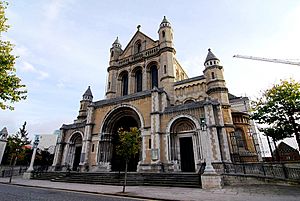 |
|
| 54°36′10″N 05°55′42″W / 54.60278°N 5.92833°W | |
| Country | Northern Ireland |
| Denomination | Church of Ireland |
| Churchmanship | High Church |
| Website | www.belfastcathedral.org |
| History | |
| Dedication | St Anne |
| Architecture | |
| Architect(s) | Sir Thomas Drew |
| Groundbreaking | 1899 |
| Completed | 1904 |
| Administration | |
| Diocese | Diocese of Connor |
| Province | Province of Armagh |
Belfast Cathedral, also known as St Anne's Cathedral, is a large church in Donegall Street, Belfast, Northern Ireland. It is a Church of Ireland cathedral. What makes it special is that it serves two different church areas: the Diocese of Connor and the Diocese of Down and Dromore. It is a main landmark in Belfast's Cathedral Quarter.
Contents
Building History
The first architect for the cathedral was Sir Thomas Drew. The very first stone, called the foundation stone, was placed on September 6, 1899. It was laid by the Countess of Shaftesbury.
Before the cathedral, there was an older church on the same spot. This old church, also called St Anne's, was built in 1776. It stayed in use until December 31, 1903, while the new cathedral was built around it. After the new part was ready, the old church was taken down. Only one piece from the old church remains in the cathedral today. It is a special window called the Good Samaritan window.
At first, only the main part of the cathedral, called the nave, was built. This section was officially opened on June 2, 1904.
Later Additions
In 1924, people decided to build the front of the cathedral. This part was meant to be a memorial for the brave men and women from Ulster who served and died in the Great War. The foundation stone for this front was laid on June 2, 1925. The completed front, designed by Sir Charles Archibald Nicholson, was dedicated in June 1927.
Around the same time, the central area where the choir sits was built. This happened between 1922 and 1924. The Baptistery, a place for baptisms, was finished in 1928. The Chapel of the Holy Spirit was dedicated on July 5, 1932. This chapel has beautiful mosaics that show Saint Patrick, a very important saint in Ireland.
A famous leader named Edward, Lord Carson was buried in the cathedral in 1935. He was a key figure in the Unionist movement. In 1941, during World War II, a German bomb nearly destroyed the cathedral. It caused a lot of damage to buildings nearby.
Work on the back part of the cathedral, called the ambulatory, started in 1955. This section was finished in 1959. However, it took another ten years to start building the north and south transepts (the arms of the cross-shaped church). There were long delays and money problems during this time.
The south transept, which includes the Chapel of Unity, was dedicated in 1974. The north transept was finished in 1981. It has a large Celtic cross on the outside and holds the Chapel of the Royal Irish Rifles.
The Spire of Hope
In April 2007, a tall, shiny stainless steel spire was added to the top of the cathedral. It is 40 meters (about 130 feet) high! This spire is called the "Spire of Hope." It lights up at night and is part of a plan to improve the Cathedral Quarter area. The bottom part of the spire actually goes through a glass platform in the cathedral's roof. This means visitors inside can look up and see it from the main area.
The Black Santa Charity Sit-Out
In 1976, the Dean of Belfast, Samuel B. Crooks, started a special Christmas tradition. He would sit outside the cathedral for the week before Christmas. He collected donations from people walking by. These donations were then given to many local charities. Dean Crooks became known as the "Black Santa" because he wore a dark outfit to stay warm.
This kind tradition has been continued by the Deans who came after him. Every year, the Dean (currently Stephen Forde) and other church leaders sit outside the cathedral. They are there from 9 a.m. to 5:30 p.m. each day to raise money for charity. They are still known as the 'Black Santa'. This tradition has raised millions of pounds for good causes over the years.
Cathedral Services
Services are held every day at Belfast Cathedral.
- Lunchtime prayers happen at 1:00 p.m. on Mondays, Tuesdays, and Thursdays.
- Holy Communion (a special church service) is held at 1:00 p.m. on Wednesdays, Saints' Days, and other Holy Days.
- A Service of Healing takes place every Friday at 1:00 p.m. in the Cathedral Hall or Chapel of Unity.
- A Choral Evensong service, with singing, is held at 5:30 p.m. every Friday.
- On Sundays, a Eucharist service (with or without singing) is celebrated at 11 a.m.
- An Evening Prayer or Evensong service is held at 3:30 p.m. on Sundays.
The Organ
Belfast Cathedral has a very large organ. It has 4 keyboards (called manuals) and is the second-largest pipe-organ in Northern Ireland. It was built by Harrison and Harrison in 1907 and later updated between 1969 and 1975. You can find more details about this amazing instrument online.
Organists of Belfast Cathedral
Here is a list of the people who have played the organ at St Anne's Cathedral:
- William Ware 1776–1825
- John Willis 1825–1847
- James Thompson May 1847–1862
- Henry A Wood 1863–1873
- Isaac Waugh Nicholl 1874–1903
- Charles J Brennan 1904–1964 (He was the first organist of St Anne's Cathedral)
- Harry Grindle 1964–1976
- Jonathan Gregory 1976–1984
- Andrew Paul Padmore 1984–1988
- David Drinkell 1988–2002
- Brian Hunter 2002–2003
- Philip Stopford 2003–2010
- Ian Barber 2010–2012
- David Stevens 2012–2019
- Matthew Owens 2019–2022
- Jack Wilson 2023-
Gallery
See also
 In Spanish: Catedral de Santa Ana (Belfast) para niños
In Spanish: Catedral de Santa Ana (Belfast) para niños
- Dean of Belfast A list of the Deans of St Anne's over time.



